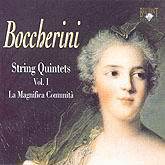Brilliant Classics
have not been content simply to present
at an incredible budget piece totally
standard repertoire. They investigate
some of the quiet corners of the chamber
repertoire and now turn their attention
to a much maligned figure. He is better
known for a single minuet, a piece which
seems to sum up (rather unfairly) the
periwigs, golden ballrooms, precision
of manners and stereotypical charms
of the late 18th Century. Luigi Boccherini
was prolific, yet much of his music
is totally unknown. His sad and poverty-stricken
life seems out of character with the
gentle bourgeois pieces that we do know.
As for his more serious music, including
these quintets, most of it has been
left to gather dust. Well, not any more.
So, let’s take stock of these works
and performances.
They are scored for
two cellos, viola and two violins not
the usual string quintet combination
but the one made famous by Schubert
in his late work in C major. The important
point about this is that the sound is
more rich and it allows the composer
a wide variety of textures. For instance
he can have one cello playing a melody
in middle register with the other acting
like a double bass keeping the harmony
underneath possibly in pizzicato. Another
texture is to have a bass melody running
in thirds or sixths underneath a descant
or three-part counterpoint or allowing
the viola and top cello to move in parallel
over a pedal point; just a few possibilities
there are many others of course, and
Boccherini exploits them.
Authentic instruments,
or I should say original instruments,
are used. It is very difficult to imagine
any new recordings of music before 1900
nowadays which do not use original instruments
... even Johann Strauss I now notice.
The effect is taut and wiry but not
unpleasant. Indeed it is often very
beautiful as with the unusual ‘Pastorale’
movement which opens the sixth quintet.
The ‘forte’ attacks are convincing and
the bass is clean and crisp. In addition
the viola can sound wondrously flute-like
in the higher register. The whole thing
is aided by the excellent Italian Abbey
acoustic and well-spaced stereo sound
picture.
These performers ‘La
Magnifica Comunita’ add to the interest
by taking great care with dynamics and
shading - some of which will not be
in the original score - and with a wider
variety of articulation even using harmonics
when a pianissimo effect seems appropriate.
They are amazingly imaginative players
who really make the music live.
Boccherini favours
the major keys, which is in keeping
with the sunny disposition most listeners
expect of him. The C minor Quintet however
(was this Beethoven’s favourite key?)
is a very fine work perhaps the gem
of the collection, and one which does
seem to point into the Romantic era.
Boccherini also favours a four movement
structure with the Minuetto as the third
movement. It is however of note that
the sixth quintet - the one which starts
with a ‘Pastorale’ - has only three
movements ending with an extended Minuetto.
The Fifth Quintet, also in three movements,
does not have a Minuetto at all. Are
the shackles of the Baroque finally
being thrown off?
Which brings us to
Boccherini’s style? He is described
in some books as "The wife of Haydn"
which implies a more feminine and less
Germanic style. Well could that mean
more tuneful? In a way yes, because
Boccherini has a typically Italian sense
of long melody sometimes harmonized
in thirds. Perhaps not as witty as Haydn?
Again yes, but listen to the allegro
movement of the Second Quintet. Boccherini
is rarely overly serious and does have
passages of wickedly flamboyant rhythms
and swinging syncopations. His harmonic
sense is Mozartian but he rarely takes
risks. His slower movements have passages
which touch on the sublime - Quintet
No. 2 movement 1 is marked ‘Amoroso’.
Sometimes early Romanticism is just
around the corner as in C minor Quintet.
He sometimes starts an opening Allegro
movement with a mysterious slow introduction
as for example in the Fourth Quintet.
Another musical highlight for me is
the two presto movements which end the
Second and Third Quintets. Haydn is
there and even possibly Rossini, and
how brilliantly played these fast movements
are.
The CD notes by Dr.
David Doughty are adequate saying much
about Boccherini’s life and musical
background but almost nothing about
the individual works. There is also
the usual performer’s biography.
Gary Higginson







